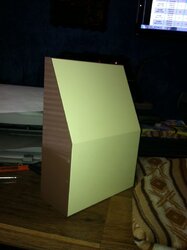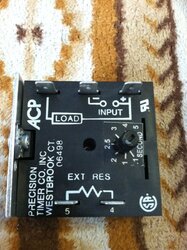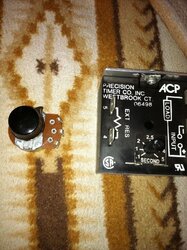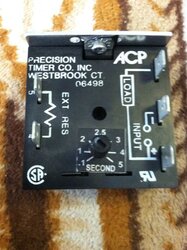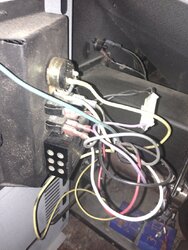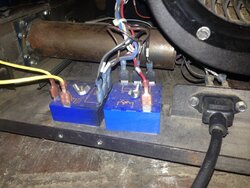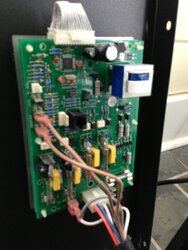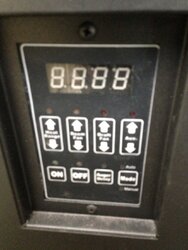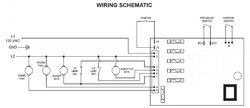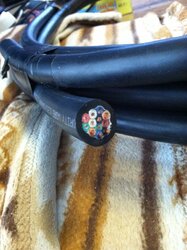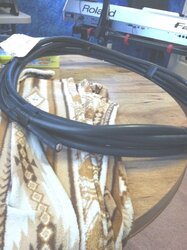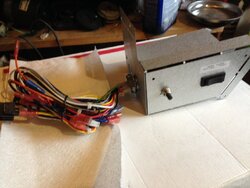Well the season is coming to a close now, and it's time to make some changes to things.
I did some desperately needed repairs on the Whitfield Prodigy II last April and before that had replaced some of the electronics with after market items.
The controller in this stove is not very flexible and as such needs some serious changes.
The draft fan is controlled by a solid state relay that is operated by the feed control triac, which also controls the room air fan.
The room air fan has a shunt tube that feeds combustion air to the fire pot too, and therein lies part of the issue.
The fire pot tends to fill up with an ashy clinker over a few hours and there is no way to separate the feed setting from the fan speed, as the feed setting is a 1 2 3 4 5 adjustment that ties the fan speed directly to the feed.
The draft fan needs to be on when starting the fire and it is wired through a door switch that also controls the main blower as well. The draft fan will stay on once the low limit switch is up to temp. The low limit serves no other function than to keep the fan running when the stove is shut down.
A new controller is available, but the one in the stove works as it was designed to, so no gain there.
I have a new heavy duty timer that will allow a feed rate of 2 seconds on time and an adjustable off time (heat setting) from 2 seconds (high) to 10 seconds (low)
This timer has a load rating of 10 amps so it is far and away better than the micro controller on the factory controller.
I have a new heavy duty draft fan (Thank to wood heat stoves ) which is larger and more robust than the factory unit.
There has always been an issue with the factory latch out relay not wanting to reconnect after a power outage or unplugging the unit.
This too has been thought through and a new heavy duty latch relay is going in in series with the two high temp snap switches.
If the stove should over heat the snaps will open and then the power to the latch out will be cut, thereby stopping the stove and the unit will not restart unless the reset is pressed.
The snap switches are the factory equipment and other than they were not reset type, are fine.
This stove does not use a low temp switch in the start circuit, so no one shot timer is needed.
The next issue was to separate the feed rate from the blower fan, and this will be done with a Heavy duty fan speed control that will allow the fan to operate in the "sweet spot" for any fire setting.
Original equipment has a "Hall Effect" sensor in the blower fan to adjust the blower speed according to the feed rate setting (this is the main stumbling block here) unplugging the hall sensor, or possibly replacing the blower with a standard fan will accomplish the needed task.
The factory fan has been there since new, so a new fan would be nice.
The stove has a pressure switch that controls the feed motor and this will be retained to assure the feed is stopped if the fan should fail or in the case of the refit, not be turned on. (Speed control does have an off position)
Next came the issue of where to mount the new controls ????
The factory location in the side of the stove is awkward and way too small of an area to mount the assorted knobs and switches.
There needs to be.
Master switch---- turns on the draft fan and sends power to the other controls
Burner switch-----controls flow of power from the timer to the feed motor
Feed rate potentiometer----controls feed motor (feed rate)
Fan speed control----- controls room air/combustion fan
So, a nice control box was needed ????????
A recent trip to Fry's produced what I needed.
The current plan is to mount this lovely little box on the wall (above grand kid level)
and connect it to the stove with a 10 conductor cable of heavy duty type.
The local electrical supply had just what was needed, and reasonably priced too.
This setup will work on any older stove that has a controller issue.
The only caviat is that if one needs an auto start, it would have to be set up with a separate timer unit.
All quite workable.
I am very excited about getting this new setup going.
The previous updates on the stove were good, but this refit should extend the little Whits life many many years.
The best part is that the electronics are OFF THE SHELF TECHNOLOGY, and not dependent on the whims of a stove company.
A shot of matching gray stove paint to the panel after its all done will make things dandy.
I will try to get piccys as we go along to show wasssssup.
Snowy
I did some desperately needed repairs on the Whitfield Prodigy II last April and before that had replaced some of the electronics with after market items.
The controller in this stove is not very flexible and as such needs some serious changes.
The draft fan is controlled by a solid state relay that is operated by the feed control triac, which also controls the room air fan.
The room air fan has a shunt tube that feeds combustion air to the fire pot too, and therein lies part of the issue.
The fire pot tends to fill up with an ashy clinker over a few hours and there is no way to separate the feed setting from the fan speed, as the feed setting is a 1 2 3 4 5 adjustment that ties the fan speed directly to the feed.
The draft fan needs to be on when starting the fire and it is wired through a door switch that also controls the main blower as well. The draft fan will stay on once the low limit switch is up to temp. The low limit serves no other function than to keep the fan running when the stove is shut down.
A new controller is available, but the one in the stove works as it was designed to, so no gain there.
I have a new heavy duty timer that will allow a feed rate of 2 seconds on time and an adjustable off time (heat setting) from 2 seconds (high) to 10 seconds (low)
This timer has a load rating of 10 amps so it is far and away better than the micro controller on the factory controller.
I have a new heavy duty draft fan (Thank to wood heat stoves ) which is larger and more robust than the factory unit.
There has always been an issue with the factory latch out relay not wanting to reconnect after a power outage or unplugging the unit.
This too has been thought through and a new heavy duty latch relay is going in in series with the two high temp snap switches.
If the stove should over heat the snaps will open and then the power to the latch out will be cut, thereby stopping the stove and the unit will not restart unless the reset is pressed.
The snap switches are the factory equipment and other than they were not reset type, are fine.
This stove does not use a low temp switch in the start circuit, so no one shot timer is needed.
The next issue was to separate the feed rate from the blower fan, and this will be done with a Heavy duty fan speed control that will allow the fan to operate in the "sweet spot" for any fire setting.
Original equipment has a "Hall Effect" sensor in the blower fan to adjust the blower speed according to the feed rate setting (this is the main stumbling block here) unplugging the hall sensor, or possibly replacing the blower with a standard fan will accomplish the needed task.
The factory fan has been there since new, so a new fan would be nice.
The stove has a pressure switch that controls the feed motor and this will be retained to assure the feed is stopped if the fan should fail or in the case of the refit, not be turned on. (Speed control does have an off position)
Next came the issue of where to mount the new controls ????
The factory location in the side of the stove is awkward and way too small of an area to mount the assorted knobs and switches.
There needs to be.
Master switch---- turns on the draft fan and sends power to the other controls
Burner switch-----controls flow of power from the timer to the feed motor
Feed rate potentiometer----controls feed motor (feed rate)
Fan speed control----- controls room air/combustion fan
So, a nice control box was needed ????????
A recent trip to Fry's produced what I needed.
The current plan is to mount this lovely little box on the wall (above grand kid level)

and connect it to the stove with a 10 conductor cable of heavy duty type.
The local electrical supply had just what was needed, and reasonably priced too.
This setup will work on any older stove that has a controller issue.
The only caviat is that if one needs an auto start, it would have to be set up with a separate timer unit.
All quite workable.
I am very excited about getting this new setup going.
The previous updates on the stove were good, but this refit should extend the little Whits life many many years.
The best part is that the electronics are OFF THE SHELF TECHNOLOGY, and not dependent on the whims of a stove company.
A shot of matching gray stove paint to the panel after its all done will make things dandy.
I will try to get piccys as we go along to show wasssssup.
Snowy


